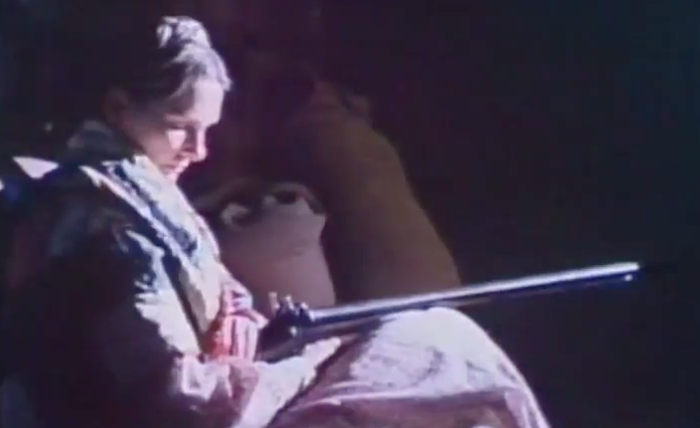
Almost halfway through her short film Wasp (2003), Andrea Arnold decides to take a break from the onward flow of the narrative and send her main characters into a kind of recess. Zoe (Natalie Press) comes out of the pub where she is flirting with a man called David to meet her kids in a parking lot where they have been waiting for her. To distract them, Zoe starts playing and dancing with them; while her oldest daughter refuses to join, the camera follows their movements, dancing timidly along trying to keep up with the rhythm of the characters. With a brief running time of 26 minutes, Arnold spends a precious minute in this sequence that disrupts Zoe’s mission of finding love and seems to disturb most principles of narrative economy in filmmaking.
The word “short” has usually accompanied the word “film” as a mere qualifier. The “short film” lets the viewer know that it’s a film like any other, except for the durational difference. The short films are those movies that simply weren’t long enough to reach the feature. But what if shortness were thought of differently? Could one think of shortness in a way that does not imply a lack, a shortage, or a longing to be longer? In filmmaking, the short form has capabilities and possibilities of its own that in many ways elude the feature. By being able to evade, or at least curtail, the imperatives of narrative economy of the feature film, short films often point to the potential of film as a medium of childish play, dance, and time-mismanagement.
By being able to evade, or at least curtail, the imperatives of narrative economy of the feature film, short films often point to the potential of film as a medium of childish play, dance, and time-mismanagement.
“When a child strikes the match-head to see what happens, just for the fun of it,” writes Jean-François Lyotard in Acinema, “(s)he enjoys the movement itself… the sterile differences leading nowhere, the uncompensated losses.”[i] In Wasp, the camera isn’t very different from this child. Arnold watches, and dances with, the bodies in her frame in a sort of dazzled torpor. Giorgio Agamben believes that dance can be a means without ends; a gesture that “consists entirely of supporting and exhibiting the medial character of bodily movements.”[ii] Dance can be conceived as a kind of bodily movement that we perform just for the fun of it. Through dance, we use our bodies as a toy and not as a tool, we play with our corporeal potentials and we watch in amazement as these movements produce nothing and exist as a useless waste of energy.

For Lyotard, the narrative film produced within capitalist industries was characterized by its fundamental mission of eliminating “aberrant movements and useless expenditures.” As a counterpart, he offered his Acinema: a kind of cinema that dwells on the unproductive and the sterile through the polar opposites within bodily movement: immobility and excessive movement. The childish dance and play of Wasp tends to and points toward the latter. At its core, the dance scene in the film is constructed around motions of wasteful intensities and a playful waste of time. Lyotard didn’t quite envision the short as a medium for his Acinema, and it is true that Arnold’s film never achieves, or even attempts, to fully escape the narrative logics of film: the majority of its movements are still constrained by the three-act structure of Zoe’s story. But although the film doesn’t make the narrative stop, it does waste its time. For a minute, the childish logic of wasteful movement takes the narrative for a playdate.
In a way, Arnold is able to enact this diversion because of the paucity of her story. With less than half an hour, Arnold’s film exemplifies the ability that the short film has to transform the screen into a small window, without worrying about what comes next. Because the short is faced with durational scarcity, some directors have responded by simply upending its narrative economies altogether. Although these directors are still trying to tell a story, they know they are faced with a losing game, so they respond by inventing a different game of their own. Perhaps this is why the short is so often constructed as snippets and scraps. Like a kid, one watches these shorts not looking for clues as to what the narrative will produce, nor waiting for the resolution of events, but just enjoying the diversion of the image. Lynne Ramsay, for example, doubles down on this mechanism of the short as child-like diversion in Small Deaths (1996). The linear flow and causal logics of a narrative aren’t Ramsay’s main concern and instead she structures her film around three discrete stories. In the second vignette, Ramsay’s camera roams and plays around with two young girls who approach the world with the curiosity and wonder of a kid watching a match. The girls, and the camera, stare at a snail for a few seconds, throw pebbles in a river, run and stumble through fields, and in the end they run into a “sacred cow.”

In a filmic universe where directors are encouraged to be efficient, economical, and try to make every frame count, Andrea Arnold and Lynne Ramsay stand out for sidestepping these constraints and for being uniquely interested in experimenting with the medium. Their filmic approach is like an experimentation through waste and play and it inundates other films like Ramsay’s Swimmer (2012) and Arnold’s Fish Tank (2009). Wasp and Small Deaths revel in unproductive and useless movements through dance and play, through gestures that do not seek to produce anything other than movement just for the sake of it. And perhaps they are able to do this because of their shortness. Since they are able to ignore the demands of resolution and cause-effect, these short films stand as a celebration of wasted time, of useless movement, and of a dance-like poetic that is more interested in playing around like a kid than in telling a story.





